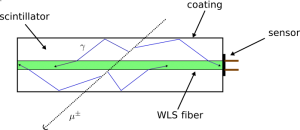Scintillation detectors
Scintillators base their detection principle on the process of excitation and de-excitation of atomic electrons in a plastic scintillator material when a charged particle passes through it. The scintillator generally has a highly diffusive and reflective coating that improves photon transport. The photons produced by the scintillation inside the scintillator strip are captured by the fiber and conducted to a photosensor for subsequent recording and analysis.
The development of scintillators with plastic support in the form of strips has allowed the construction of cosmic ray detectors that are capable of withstanding the difficult environmental conditions that may appear in certain detection sites. New hybrid cosmic ray detectors are currently being designed, combining for example water Cherenkov detectors and plastic scintillators. The purpose of this is to increase the separation efficiency of the signals coming from the atmospheric cascades of particles. This hybrid technique is being proposed as one of the possible improvements for the design of the Pierre Auger Observatory to study the composition of cosmic rays at the highest energies or in the construction of muon telescopes such as MuTe.
